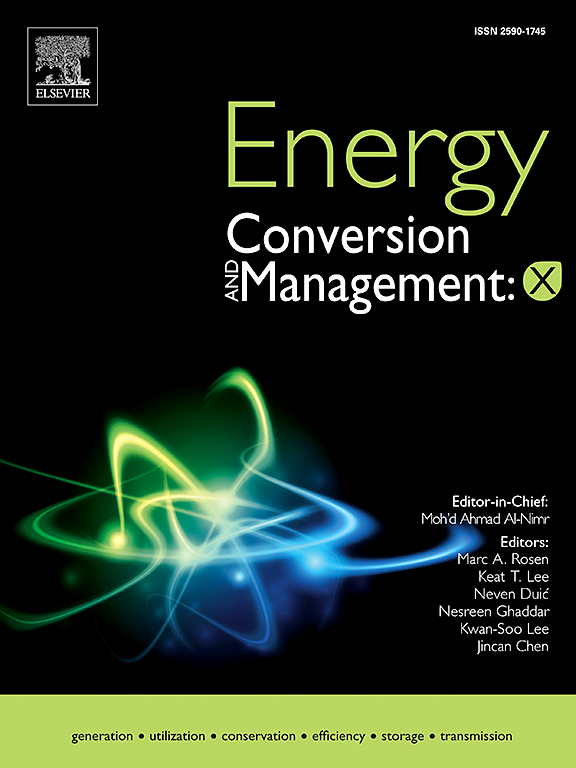Strategic conversion of algal and lignocellulosic biomass wastes as mixed feedstock for enhanced and environment-friendly production of bioethanol
IF 10.9
1区 工程技术
Q1 ENERGY & FUELS
引用次数: 0
Abstract
Microalgal biorefineries produce biodiesel and other value-added products, often leaving defatted biomass as waste. This study focused on efficient conversion of defatted biomass of Chlorella vulgaris into fermentable sugars for bioethanol production. The biomass was first subjected to chemical pretreatment followed by cellulase-catalyzed saccharification of the pretreated biomass to release 4.74 ± 0.46 g L−1 fermentable sugars, predominantly containing glucose and xylose. Bacillus subtilis was used to produce crude cellulase which exhibited a maximum specific activity of 12.11 ± 0.15 U mg−1. The resulting sugars were fermented by Kluyveromyces marxianus to yield 2.10 ± 0.25 g L−1 bioethanol. To enhance the concentration of fermentable sugars, rice husk, a lignocellulosic waste, was co-utilized after pretreatment. A mixed hydrolysate of microalgal and rice husk biomasses yielded 39.82 ± 3.48 g L−1 fermentable sugars, predominantly containing glucose and xylose, from which 17.50 ± 0.44 g L−1 bioethanol was produced after fermentation in a 3.7 L controlled fermenter. The mixed hydrolysate resulted in an 8-fold increase in bioethanol concentration when compared to microalgal hydrolysate alone. The environmental impacts of the processes were assessed through life cycle analysis, based on parameters such as, human carcinogenic toxicity, fossil resource scarcity, global warming potential, ozone formation impacts, fine particulate matter formation, freshwater eutrophication potential, and terrestrial acidification potential. The analysis revealed that bioethanol derived from the mixed hydrolysate was 14 times more environmentally friendly than that from microalgal hydrolysate alone. This study showcased an efficient conversion of a strategic mix of second and third-generation feedstocks to enhance the yield of fermentable sugars using a bacterial cellulase, thereby promoting resource recovery from organic wastes.

战略性转化藻类和木质纤维素生物质废料作为混合原料,以增强和环境友好型生产生物乙醇
微藻生物精炼厂生产生物柴油和其他增值产品,通常将脱脂生物质作为废物。本研究的重点是将普通小球藻的脱脂生物质有效转化为可发酵糖,用于生物乙醇生产。首先对生物质进行化学预处理,然后对预处理后的生物质进行纤维素酶催化糖化,释放出4.74±0.46 g L−1的可发酵糖,主要含有葡萄糖和木糖。以枯草芽孢杆菌为原料制备粗纤维素酶,最大比活性为12.11±0.15 U mg−1。所得糖经马氏克鲁维菌发酵,产2.10±0.25 g L−1生物乙醇。为了提高可发酵糖的浓度,对木质纤维素废弃物稻壳进行预处理后的协同利用。微藻和稻壳生物质的混合水解产物产生39.82±3.48 g L−1可发酵糖,主要含有葡萄糖和木糖,其中在3.7 L控制的发酵罐发酵后产生17.50±0.44 g L−1生物乙醇。与单独的微藻水解液相比,混合水解液导致生物乙醇浓度增加8倍。基于人类致癌毒性、化石资源稀缺性、全球变暖潜势、臭氧形成影响、细颗粒物形成、淡水富营养化潜势和陆地酸化潜势等参数,通过生命周期分析对这些过程的环境影响进行了评估。分析表明,从混合水解液中提取的生物乙醇比从单独的微藻水解液中提取的生物乙醇环保性高14倍。本研究展示了利用细菌纤维素酶对第二代和第三代原料的战略组合进行有效转化,以提高可发酵糖的产量,从而促进有机废物的资源回收。
本文章由计算机程序翻译,如有差异,请以英文原文为准。
求助全文
约1分钟内获得全文
求助全文
来源期刊

Energy Conversion and Management
工程技术-力学
CiteScore
19.00
自引率
11.50%
发文量
1304
审稿时长
17 days
期刊介绍:
The journal Energy Conversion and Management provides a forum for publishing original contributions and comprehensive technical review articles of interdisciplinary and original research on all important energy topics.
The topics considered include energy generation, utilization, conversion, storage, transmission, conservation, management and sustainability. These topics typically involve various types of energy such as mechanical, thermal, nuclear, chemical, electromagnetic, magnetic and electric. These energy types cover all known energy resources, including renewable resources (e.g., solar, bio, hydro, wind, geothermal and ocean energy), fossil fuels and nuclear resources.
 求助内容:
求助内容: 应助结果提醒方式:
应助结果提醒方式:


